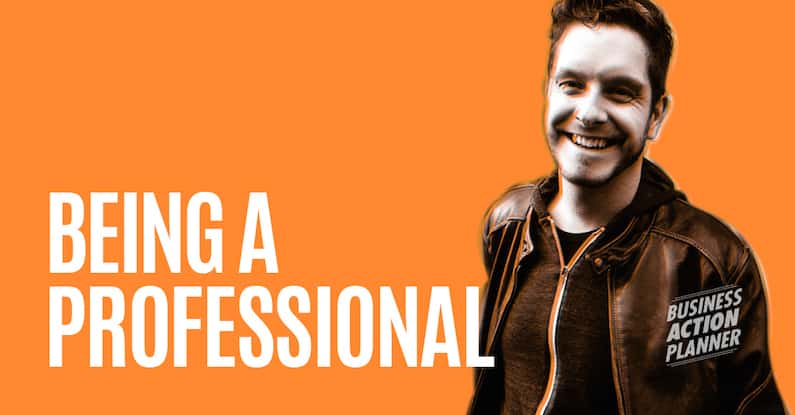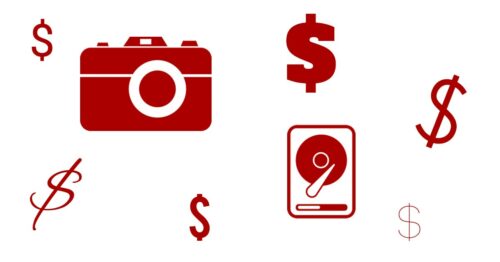A lot of creatives want to ‘turn pro’ or ‘go pro’ but it’s a destination that tends to be quite elusive. The brass ring is often considered out of one’s grasp for a laundry list of reasons such as needing more clients or charging more money. But more doesn’t solve any problems. More is just more. More stress and more bills and less time and less joy won’t increase the quality of your life (or the lives of those you’re trying to create value for).
In my experience in working with both emerging and full-time creative talent it has become blatantly obvious to me that being a professional has nothing to do with how much revenue one generates, but rather how they conduct themselves as a service provider. A freelancer will be perceived as a hobbyist if they offer their services, and perform their creative work, in a casual or chaotic manner. In order to be a viable alternative within a given market, a creative must conduct themselves professionally no matter how much time or resources they allocate to their venture. My take on this subject is that it’s best tackled by looking at the big picture (macro) and then the day-to-day conduct (micro).
Here are three (3) macro things that stand out to me as ways a freelancer can have a more professional approach to their work:
Pursue creative risks, not financial ones.
The successful creative business owners I know have gotten to where they are because they’ve challenged the status quo of their given target audience through their creative vision and expertise. The perfect piece of gear or the pre-maturely ditched day job will not help a creative win the entrepreneurial lottery. Those who push the creative envelope do better than stand out in a crowd—they draw a crowd. They make people curious and that’s the best marketing tactic there is. Creative risk is what should fuel your freelancing fire, not anxiety about paying your bills through a freelance venture that is not yet mature enough to carry the load.
Be on brand and deliver on your promises.
Brand building has a lot less to do with logos and marketing collateral and a lot more to do with the character and integrity of the service provider themselves. A successful independent business conveys with confidence a clear offering at a fair rate and then the planning and execution of that work is handled professionally. Buyers of freelance services are not making a purchase from a company; they’re putting their faith and trust in you, the human, the talent, so respect the risk they’re taking. Display creative work that you know you can replicate either aesthetically or logistically because that’s what buyers are buying… they see something you’ve done and they ‘want that’ (in some form or fashion).
Set timelines and goals for the project and then meet, or exceed them, so the buyer’s confidence grows as they work with you—verses the stereotypically awkward experience of working with a ‘creative type’. Allow your actions to speak louder than your portfolio and your words.
Learn about the craft of business.
Education is around every corner, but a freelancer needs to balance the development of their craft with their business acumen. Success is found in the life-long pursuit of being a consummate professional and at some point, usually sooner than later, a creative has spent enough time nerding out in Adobe (or what-have-you) and it’s time to hone the skills necessary to run a viable business. Instead of just saying, “I’m not good at the business stuff,” maybe it’s time to dig into the cogs of the machine that you don’t understand or enjoy and find the things that you do want to improve upon.
Starting and growing a small business doesn’t need to be boring or scary. As you learn which administrative or marketing efforts fit your style it can be very exciting to explore and share your work and your services. Find the resources, events, training, and peers that can help you better understand how to build and sustain a successful, self-inflicted creative career. You don’t have to “Go Pro” in order to call yourself a professional, you simply need to be professional.
There is no magical transformation from amateur to professional and there’s no “jump” to be made. Like with every start-up, there’s a progression, a journey of establishing value and meeting needs within the marketplace and steering a moving ship. Professionalism is an attitude that must be acted upon; otherwise you’re just a martyr for your craft.
Here are a few action items (micro) to help you get down to business no matter how much time you have or money you make:
Web-world. Create a simple, responsive, full-width website that has your contact information in the header/footer – check out Photoshelter.com. Ensure your creative work is viewable in full-screen mode and update your site at least once a month. Only promote the social networks that serve your business relationships.
Email at the right time. Aim to send emails to prospects, clients, and vendors during appropriate business hours – 6:00am to 6:00pm for example; otherwise one of two things could happen: 1) you incite a late-night email exchange that you’re not fully prepared to handle professionally; or 2) your email ends up in a giant pile of digital chaos the next morning when they first check their inbox. If you write emails late at night, that’s fine, but re-read or edit them in the morning before you send them.
Make meetings work. Schedule meetings with clients or collaborators in the morning, the earlier the better. Having to be “on your game” right out of the gate helps you get focused on your business and keeps the personal or domestic distractions to a minimum. Schedule meetings prior to a coffee break or lunch time so that you can extend the meeting to a more social setting (and by treating them to a coffee or meal you’re showing them you value the relationship).
Go dark. Turn off your electronic devices when you’re in social settings or in meetings. Constantly responding to texts and emails in front of others is both rude and foolish. Face-to-face engagement matters more than the next message.
Get a routine going. Set a daily, weekly, monthly, and quarterly routine. Don’t overload your schedule with mundane tasks, but populate your calendar at regular intervals with a few key elements that will ensure your business keeps running smoothly. If you need some help building and maintaining a routine then hire a productivity coach to keep you accountable and on track – check out Mike Vardy’s Productivityist.
Be a timekeeper. Track your time so you know what your client business requires of you. Understanding the cost of business requires not only keeping your accounts in order, but also taking stock of the time it takes to satisfy the needs and wants of your clients, customers, and yourself. Be easy to live with. If applicable, set reasonable expectations with your spouse or partner; don’t always drift back to your work. If you need extra time, negotiate with your spouse/ partner instead of simply working all the time. Being a good businessperson requires handling the personal side of your life with good etiquette; you want your family to be supportive, and workaholism doesn’t foster support. Freelancing is hard work but know this: your talent and passion are best served by exuding a professional attitude. Conducting yourself as a professional will help to set you apart from your peers and it will better prepare you for success in more ways than you may realize.
I wish you great success as you get down to business. Rock on! – Corwin
This article was originally published in Issue 2 of Corwin’s free PDF mini-magazine MEMO 2 FREELANCERS. Get exclusive business and marketing insights, Q&As with creative freelancers and a shot of inspiration by subscribing to this awesome publication (also available at www.BusinessActionPlanner.com).










